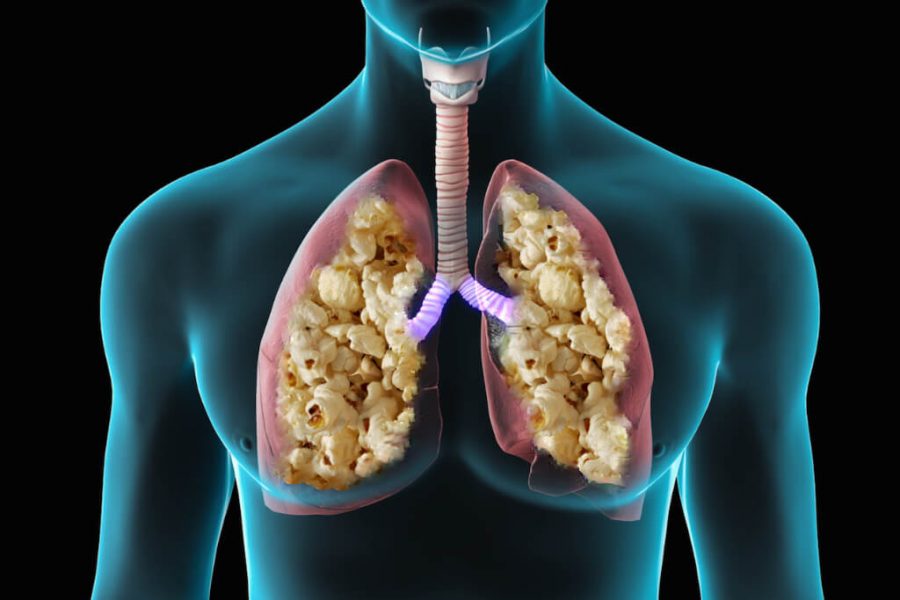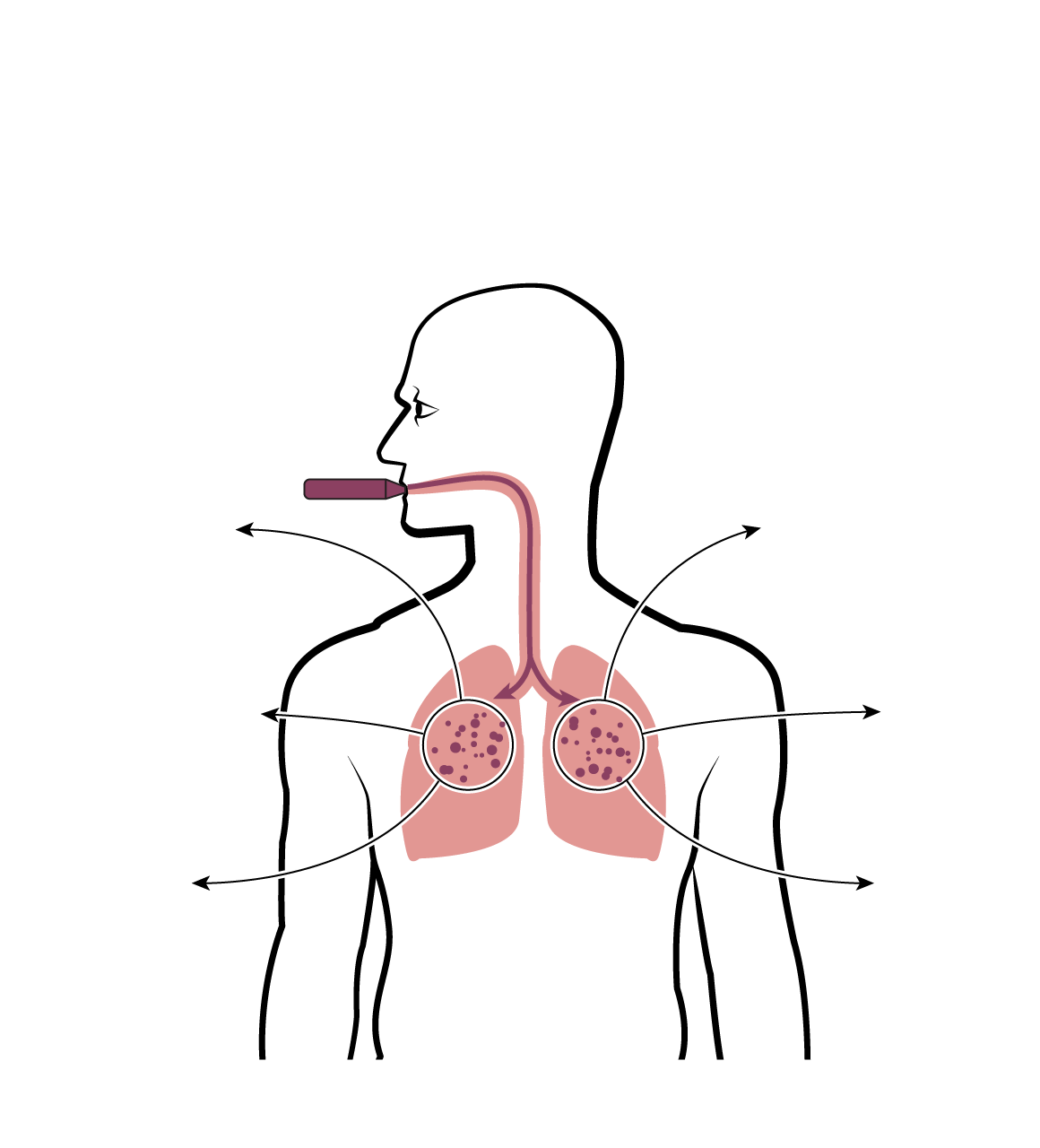
What Are the Side Effects of Vaping on the Lungs?
- Mucus - Vaping stimulates the production of mucus by the cells in the lungs. Lungs can effectively expel mucus. ...
- Infection - Vaping damages the immune cells in the lungs. ...
- Less Airflow - Alveoli are small air passages responsible for the exchange of air in the lungs. ...
- Ciliary Damages - Cilia are thin hair-like structures present in the lungs. ...
Is vaping bad for Your Lungs?
Yes it is. Studies suggest that vaping may have negative effects on the lungs, but more research is needed.In particular, a 2015 study examined the effects of flavored e-juices on both human lung cells and lung cells in mice.
What are the negative health effects of vaping?
The short-term side effects of using nicotine vapes are usually:
- Lingering aftertaste
- Light-headedness
- Sweating
- Headache
- Nausea and vomiting
- High blood pressure
- Increased heart rate
Why vaping is bad facts?
Vaping is not only bad for lung health, but it also causes problems for the teeth and gums as well. One study conducted in 2018 showed that several e-juices caused bacterial growth on the teeth, which led to users developing cavities.
Can vaping stunt Your Lungs?
When combined and heated to a vapor, these substances have beeen shown to cause as much inflammation in the lung tissue as traditional cigarette smoke inhalation. While many consider vaping to be a much milder hit to the lungs than traditional cigarette smoke (it is), acute and chronic damage is still being done.

What are the symptoms of vapors?
Typically, symptoms have started gradually, with shortness of breath and/or chest pain before more severe breathing difficulty led to hospital admission.
How many puffs can you have with vaping?
With vaping, you can have one or two puffs, be satisfied, and be done whenever you want. You are not committed. You might only need one puff, then maybe five minutes later you take another one. You won’t overdo because your brain will never have to justify it as an expense if you stop now. You just stop now.
What are the effects of smoking?
The recent tragic and alarming cases of severe lung disease are clearly cause for concern. A number of other health effects are also worrisome: 1 Nicotine is highly addictive and can affect the developing brain, potentially harming teens and young adults. Even some "nicotine-free" e-cigarettes have been found to contain nicotine. 2 Some substances found in e-cigarette vapor have been linked to an increased risk of cancer. 3 Teens who vape are more likely to begin smoking cigarettes. 4 Explosions and burns have been reported with e-cigarettes while recharging the devices, due to defective batteries. 5 Accidental exposure to liquid from e-cigarettes has caused acute nicotine poisoning in children and adults. 6 Vaping during pregnancy could harm a developing fetus.
What are the chemicals in e-cigarettes?
E-cigarettes produce a number of dangerous chemicals including acetaldehyde, acrolein, and formaldehyde. These aldehydes can cause lung disease, as well as cardiovascular (heart) disease. Electronic cigarettes, or e-cigarettes, put nicotine into your lungs and bloodstream.
How many people have lung disease from e-cigarettes?
According to the CDC: Nearly 200 e-cigarette users have developed severe lung disease in 22 states (and the numbers keep rising — a Washington Post story put the number at 354). Most cases were among teens and young adults.
What is the e-cigarette called?
The Centers for Disease Control and Prevention has created a web page with the latest information and recommendations about what is now being called EVALI (for e-cigarette, or vaping, product use associated lung injury).
Can e-cigarettes cause nicotine poisoning?
Accidental exposure to liquid from e-cigarettes has caused acute nicotine poisoning in children and adults.
Where was the first vaping case?
The first confirmed vaping-related case at The Ohio State University Wexner Medical Center occurred this summer. For the most part, these cases are young, healthy individuals who developed severe respiratory problems after vaping.
Is vaping a respiratory illness?
Lung and Pulmonary. September 30, 2019. A mysterious, life-threatening, vaping-associated pulmonary illness is currently sweeping the nation. The severity of many of the cases is alarming. Healthy—and often young—people are coming into the hospital with severe respiratory failure. Some end up on ventilators or medically induced comas, ...
Does nicotine affect the brain?
Research shows that nicotine can affect the development of your lungs and brain. Keep in mind that your brain continues to develop until your 20s. The amount of nicotine in one JUUL pod is the equivalent of smoking a pack of cigarettes.
Is vaping bad for you?
The severity of the vaping cases nation wide show that e-cigarettes can be risky. Vaping can cause shortness of breath, chest pain, nausea, vomiting, fever, diarrhea, abdominal pain and hypoxia. Once-health y lungs are suddenly inflamed and struggling to function properly without the aid of a ventilator or medication.
Is vaping unregulated?
Your lungs are meant to breathe in fresh air and nothing else. “The vaping industry is completely unregulated. There’re so many different brands and variations of liquids and additives that research can barely keep up to determine the health risks of e-cigarettes.”.
Do e-cigarettes contain nicotine?
While not all e-cigarettes contain nicotine, they still have chemicals in them that can irritate the lungs. When e-cigarettes were first introduced, they were touted as a safer alternative than cigarette smoking. But the severity of the vaping cases nationwide shows that’s not necessarily true.
Is vaping safe for young people?
The FDA has been very blunt in warning that vaping is “not safe for youth, young adults, pregnant women or adults who do not currently use tobacco products.”. If you’re using vaping as a way to kick your cigarette habit, you may want to try a different method that’s been proven safe and effective.
Why are electronic cigarettes considered a safer alternative to tobacco?
Electronic cigarettes, or e-cigarettes, were thought to be the answer in helping those addicted to traditional tobacco cigarettes switch to a safer alternative, and ideally quit such products altogether. As e-cigarettes contain the addictive component nicotine but no tobacco, the carcinogenic risk was much lower. The continued use of nicotine and the act of inhaling would ideally satisfy an individual hoping to quit traditional tobacco cigarettes.
Is e-cigarettes safe?
Share to Linkedin. Electronic cigarettes, or e-cigarettes, were thought to be the answer in helping those addict ed to traditional tobacco cigarettes switch to a safer alternative, and ideally quit such products altogether. As e-cigarettes contain the addictive component nicotine but no tobacco, the carcinogenic risk was much lower.
Does vaping cause lung damage?
But even before these recent acute events of lung disease and death, vaping was still causing chronic lung damage.
Does vaping cause bronchitis?
What's more, those cells exposed to flavored aerosolized vaping liquid showed even higher levels of inflammatory substances (known as interleukins). These substances are known to contribute to chronic inflammatory diseases of the airway and lungs, making individuals more susceptible to chronic bronchitis and pneumonia.
Does vaping affect lung cells?
In one laboratory study, human lung cells were exposed to e-cigarette aerosolized liquid. The cells were re-examined after exposure, and demonstrated altered shape, and shorter cellular lifespan. What's more, those cells exposed to flavored aerosolized vaping liquid showed even higher levels of inflammatory substances (known as interleukins). These substances are known to contribute to chronic inflammatory diseases of the airway and lungs, making individuals more susceptible to chronic bronchitis and pneumonia.
What is the cause of vaping-related pneumonia?
Vaping-Related Lipoid Pneumonia. Unlike the classic pneumonia caused by infection, lipoid pneumonia develops when fatty acids (the building blocks of fat) enter the lungs. Vaping-related lipoid pneumonia is the result of inhaling oily substances found in e-liquid, which sparks an inflammatory response in the lungs.
How to heal a collapsed lung?
But more advanced cases require a chest tube to drain leaked oxygen from the body cavity or surgery to repair the hole in the lung .
What is the term for a hole in the lung that causes oxygen to escape?
Primary spontaneous pneumothorax , or collapsed lung, occurs when there’s a hole in the lung through which oxygen escapes. This can be the result of an injury — such as a gunshot or knife wound — or when air blisters on the top of the lungs rupture and create tiny tears.
What to do if your lung hurts?
What to Do If Your Lungs Hurt. If you smoke or vape, don’t brush off chest or lung pain as something that’s normal. If you have pain or other symptoms associated with breathing difficulties, such as shortness of breath and chronic cough, it’s important to see a doctor.
Does diacetyl cause lung inflammation?
Diacetyl is frequently added to flavored e-liquid to enhance the taste. Inhaling diacetyl causes inflammation and may lead to permanent scarring in the smallest branches of the airways — popcorn lung — which makes breathing difficult. Popcorn lung has no lasting treatment.
Does vaping affect the lungs?
Instead of bathing lung tissue with a therapeutic mist, just as a nebulizer does, vaping coats lungs with potentially harmful chemicals. E-liquid concoctions usually include some mix of flavorings, aromatic additives and nicotine or THC (the chemical in marijuana that causes psychological effects), dissolved in an oily liquid base.
Is vaping bad for your lungs?
By now, it seems pretty clear that using e-cigarettes, or vaping, is bad for your lungs. But research about exactly how vaping affects the lungs is in the initial stages, says Johns Hopkins lung cancer surgeon Stephen Broderick.
How does vaping work?
Vaping devices can vary in shape, size and color. Devices produce an aerosol byproduct from heating up a liquid that sometimes consists of flavorings and other chemicals that make vaping seem less harsh (initially at least) than smoking. This liquid delivers nicotine, marijuana, or other drugs to the user via a mouthpiece that is inhaled into the lungs then expelled via the mouth or nose.
What is vaping a cigarette?
A "vape," or electronic cigarette, is a device that heats up a liquid to create a vapor you inhale. Some types of vaping devices include pens, e-cigarettes (like JUUL), ...
How does nicotine affect the brain?
Nicotine use affects how the synapses—connections between brain cells— are formed. Regular usage in adolescence can also increase the risk for future addiction to cigarettes and other drugs. Other than nicotine, vaping liquid and subsequent vapor may include other harmful substances including: Cancer-causing chemicals.
How many people died from vaping in 2019?
There were morethan2,500cases of users being hospitalized for vaping-related injury as of December 17, 2019. Vaping has also led to 54 deaths across 27 states and the District of Columbia.
What is Juulpod nicotine?
While many of these products typically feature a liquid containing one-third-to-half the nicotine found in a cigarette —for example, one 5% strength JUULpod is designed to replace an entire pack of cigarettes in nicotine strength—vaping users still face many health and safety risks.
How many kids use e-cigarettes in high school?
According to 2018 National Youth Tobacco Survey (NYTS) data, 3.6 million children in middle school and high school use e-cigarettes. Use, defined by at least once per day over the past 30 days, has increased 78 percent from 11.7 to 20.8 percent in 2018.
Does vaping put you at risk?
Vaping manufacturers knowingly put you at risk
